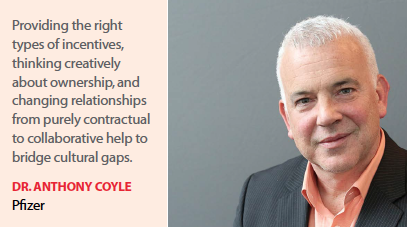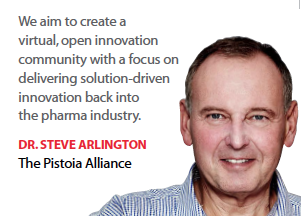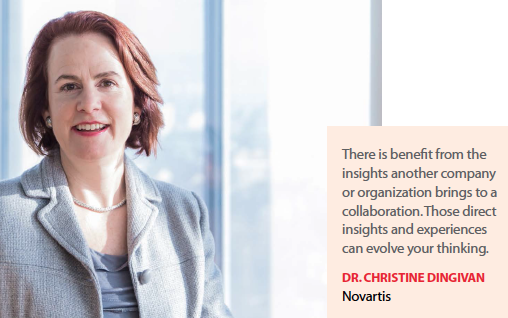 The pressure on the pharmaceutical industry to bring innovative medications to the market — as well as address issues related to access, cost, and value — is requiring new ways of doing research and development. Couple this with how quickly science is advancing and the volume of data that is being created from many sources, it’s become clear to industry leaders R&D is not something that can be done in a silo.
The pressure on the pharmaceutical industry to bring innovative medications to the market — as well as address issues related to access, cost, and value — is requiring new ways of doing research and development. Couple this with how quickly science is advancing and the volume of data that is being created from many sources, it’s become clear to industry leaders R&D is not something that can be done in a silo.
Collaboration with other companies, with patient groups, with academic organizations, and with technology companies outside the industry has now become the norm in pharmaceutical R&D.
“Science has always stood on the shoulders of the generation before," says Nick Lynch, Ph.D., investment manager, The Pistoia Alliance. “With the increase in pace of scientific discovery, the growth in data, and the challenges that the industry faces around commercial issues with drug and value-based pricing, our industry has to keep innovating. To innovate, we often need to call upon the things that other people have done to get an effective outcome."
Differences in core capabilities and risk appetite can drive collaboration, says Alan Wills, D.Phil., CSL Behring’s senior VP, strategy and business development.
“For example, larger companies with a franchise-leading product may excel at regulatory, manufacturing, and commercialization, while small biotech businesses, academic institutions, and venture capitalists can take riskier approaches to unproven yet potentially transformative technology," he says. “When risk associated with an innovative program has been sufficiently minimized, collaboration could be attractive for both partners."
Dr. Wills says licensing deals and collaborations may be a lifecycle management opportunity for an established franchise via a platform improvement or a therapy that has potential to improve standard of care. He points to the company’s January announcement of an agreement with a biotech company specializing in the characterization and engineering of complex drugs as an example.
“Our recent license and collaboration deal with Momenta Pharmaceuticals is an example where their cutting-edge technology could help transform care for patients who are treated with immunoglobulins," he says. “The collaboration also offers opportunities to partner on platform expansions beyond the initial product."
There is a benefit from the insights another company or organization brings to a collaboration, says Christine Dingivan, M.D., global head of portfolio strategy and innovation, Novartis.
 “Those direct insights and experiences can evolve your thinking," she says. “External perspectives are really important, whether the insights come from another company or from a public–private partnership. Working in pharma companies, we can sometimes become insular in our thinking about drug development strategies. External partnerships, in whatever shape or form they may take, can broaden our thinking."
“Those direct insights and experiences can evolve your thinking," she says. “External perspectives are really important, whether the insights come from another company or from a public–private partnership. Working in pharma companies, we can sometimes become insular in our thinking about drug development strategies. External partnerships, in whatever shape or form they may take, can broaden our thinking."
Novartis is one company that is pursuing partnering as a way to boost efficiency and accelerate the R&D process. The company has an external network of more than 300 academic and 100 industry alliances in oncology, immuno-oncology, regenerative medicine, neuroscience, and immunology.
“A key part of these collaborations is that we are able to access perspectives on a particular disease area," Dr. Dingivan, says. “We have a strong neuroscience history in multiple sclerosis with Gilenya, as just one example. But we’re not necessarily the sole experts in areas like migraine or Alzheimer’s disease, which has been very retractable to new drug development."
To strengthen its position in the Alzeheimer’s space, Novartis has entered into a collaboration with Amgen. In September 2015, the two companies partnered to develop a BACE inhibitor program in Alzheimer’s disease, where Novartis’ oral therapy CNP520 is the lead molecule.
“The idea of doing peer-to-peer collaboration is to cross-fertilize and maximize our knowledge in that space," Dr. Dingivan says. “Collaborating helps us gain insights and hopefully make us more successful in developing new drugs in those disease areas, but also to share some of the risk.
Alzheimer’s has turned out to be a very difficult and risky area for drug development, and it’s one of the highest unmet medical needs in the industry still, so there’s an opportunity for us to risk share."
Novartis is also committed to building smarter clinical trials, Dr. Dingivan says.
 “We are looking for ways of innovating how our clinical trial conduct is done so that we become more efficient and innovative in getting drugs approved," she says. “It’s an exciting time now in terms of new tools being developed to help us in our drug development efforts to be more effective."
“We are looking for ways of innovating how our clinical trial conduct is done so that we become more efficient and innovative in getting drugs approved," she says. “It’s an exciting time now in terms of new tools being developed to help us in our drug development efforts to be more effective."
Open Collaboration
Over the last decade, pharma companies, academic institutions, and patient groups have been forming precompetitive, open collaboration in the discovery phase. These collaborations aim to fill informational gaps in pharmaceutical research knowledge and fund translational research efforts. These research alliances can be related to specific disease areas or more general collaborations.
One such effort is The Pistoia Alliance, a global, not-for-profit alliance of life-sciences companies, vendors, publishers, and academic groups. It was established in 2009 by representatives of AstraZeneca, GlaxoSmithKline, Novartis, and Pfizer who met at a conference in Pistoia, Italy. The group has more than 50 pharma/biotech and informatics company members and about 30 academic, nonprofit, government agency, and individual members.
Dr. Lynch says the alliance was founded after a conversation among the group’s founding companies, in which they realized they were doing much of the same basic research.
“There was interest in understanding what the companies had in common, and then collaborating to solve problems," he says. “We found we could reduce risks both in terms of effort and hopefully dollars spent and have a better outcome."
The alliance brings members together to identify the causes that lead to inefficiencies and reduce duplication of effort and then develop best practices, implement a common technology, identify and disseminate standards, and overcome common obstacles to enhance innovation.
“We aim to create a virtual, open innovation community with a focus on delivering solutions-based innovation back into the pharma industry," says Steve Arlington, Ph.D., president, The Pistoia Alliance.
“The intellectual property that we bring belongs to all of the members and those that work on the programs," he adds.
The Alliance’s work is open via its website for the public to see and provide comment.
“Anyone can see the information and anyone can put forward an idea," Dr. Lynch says. “This is a way to triage ideas. Members then discuss which ideas to pursue, which need more analysis on, and then we further refine the ideas to create the projects to actively work on with the support of our members."
One project the group is working on is HELM, a macromolecule standard. The Pistoia Alliance formalized the HELM notation, originally created by Pfizer scientists as an open standard in early 2013, and publicly released the related software toolkit and editor to the community. Since its release, HELM has benefited from a list of adopters and contributors, including Bristol-Myers Squibb, Pfizer, Novartis, Roche, GSK, Ionis, and Merck plus informatics supporting its usage.
“We’ve extended the work of one company to make it an industry standard that can be used in some FDA submissions," Dr. Lynch says. “All of the activities that we do ultimately are put back into the public domain. We’re very much adopting the same principles of an open source software project."
Another project is the Chemical Safety Library, which makes available information about hazardous reactions to help make laboratories safer across the chemical industries.
“We are compiling the potential issues and even mistakes that might have caused an incident or a potential incident to help reduce that risk in the lab or in a scale up," Dr. Arlington says. “We are crowdsourcing this information across the community."
A newer project of the Alliance is The Antibody Project to enhance the collection of antibodies data to empower better research into antibody structure. This project is currently in the fundraising stage. The Alliance is also seeking input from members on potential projects associated with wearables, the Internet of Things, a unified Chemistry Data Model, and a real-world data platform.
Another more recent open collaboration is The Collaborative Trajectory Analysis Project, or cTAP, founded in 2015 to enable clinical experts to solve the most critical problems in clinical development for Duchenne muscular dystrophy. cTAP has forged alliances with clinical experts, drug companies developing therapies, patient advocacy organizations, and collaborating registries and clinical centers across Europe and the United States.
Susan Ward, Ph.D., founder and executive director of cTAP, says the project was established in partnership with James Signorovitch, a VP at the Analysis Group, to bring statistical methods that had not been used in the Duchenne community to analyze the natural history disease trajectories of patients.
“We wanted to leverage the work that had been done in other diseases and bring these same principles to the Duchenne field and see if we can find a way of reducing the unwanted variance in trials to hopefully stratify patients and improve on existing prognostic models. Ultimately we hope to develop robust matching between placebo arm data and natural history to minimize the necessity of always having to conduct placebo controlled trials, a major goal for patients."
Dr. Ward points out that clinical trials in Duchenne have been challenging because the disease progresses differently for patients, which makes it challenging to determine a drug’s efficacy amid the “noise" caused by those differences between patients.
“In a rare disease, it is not an option to run very large trials," she says. “So, it’s crucial that we learn new ways of managing patient recruitment, retention, and so on."
The Project brings together CureDuchenne and Parent Project Muscular Dystrophy along with several pharmaceutical companies that have sponsored the research — Pfizer, Shire, BioMarin, Sarepta, PTC Therapeutics, Bristol-Myers Squibb, Solid Biosciences, Catabasis, Lilly, Marathon Pharmaceuticals, and Italfarmaco.
“The Duchenne advocacy groups have been very astute in fostering and sponsoring the collection of natural history data for quite some time," Dr. Ward says. “Our challenge now is to translate our new understanding of heterogeneity in Duchenne into practical tools for clinical trial design; smarter clinical trials are the surest means for drug developers to bring new therapies to patients sooner."
Pharma/Academic Collaborations
The overall environment for basic biomedical research and clinical research has changed. In the coming years, experts say academic collaborations will emerge around gaining deep clinical insight, digital medical solutions, and care services infrastructures. These hold the promise of delivering tremendous impact for pharmaceutical research.
“A lot has changed in terms of government funding for basic research; it’s relatively flat in real dollars from the NIH, which has put stress on basic biomedical research," says Nils Lonberg, Ph.D., head of oncology biology discovery, Bristol-Myers Squibb.
Pharma continues to increase its interest in academic research as a starting point for new medicines, says Carolyn Buser-Doepner, Ph.D., head of academic collaborations group, GlaxoSmithKline.
 “We’re seeing that academic institutions have choices as to how they might approach drug discovery," she says. “Pharma companies are increasing their sourcing and outreach to academia. At the same time, there remains an underlying reality that few academics succeed on their own in developing a new medicine. There is a lot of opportunity between industry and academic for collaboration."
“We’re seeing that academic institutions have choices as to how they might approach drug discovery," she says. “Pharma companies are increasing their sourcing and outreach to academia. At the same time, there remains an underlying reality that few academics succeed on their own in developing a new medicine. There is a lot of opportunity between industry and academic for collaboration."
For example, GSK has a collaboration with Johns Hopkins in the area of rosacea. A Johns Hopkins researcher has discovered a link between a particular mast cell receptor and allergic-type reactions to foreign substances. The link makes that particular receptor an attractive target for the development of drugs that block the mast cell’s allergic-type side effects, including itchiness, redness, and rashes.
This collaboration came about through the company’s Discovery Fast Track Challenge. The program is sponsored by GSK’s Discovery Partnerships with Academia (DPAc) group to provide an opportunity for academic researchers in Europe and North America to collaborate with GSK.
In 2014, researchers at Johns Hopkins pitched the concept to DPAc and Johns Hopkins was named one of six North American winners. This past fall, after about a year of engagement, they agreed to continue the collaboration for the development of an effective treatment for rosacea and contact dermatitis.
“We’ve now formed a long-term collaboration," Dr. Buser-Doepner says. “Our internal team is working with the investigator. We meet monthly to share all the data, compounds, the models, etc. This collaboration has the look and the feel of what we do internally."
“A lot of great biology occurs within academia," she says. “There are scientists and researchers who not only think hard about their specific target and its pathway but also work hard toward developing the optimal or best possible preclinical model systems. They’ve vetted the biology. Within pharma, we are good at translating early biology toward a medicine. We have the facilities, the chemistry, the safety assessment, and the clinical trial capabilities."
In 2016, the Discovery Fast Track Challenge included three challenges in three geographic areas: Boston, the mid-Atlantic, and London. GSK is in the process of selecting the winner for the mid-Atlantic challenge.
Dr. Buser-Doepner says the company looks for targets that hit a couple of very specific criteria: there has to be some degree of target validation, it has to be novel, there has to be a clear line of sight into the clinic, and it has to fit broadly into the therapeutic areas GSK focuses on so that the company can bring the needed internal expertise to the collaboration.
Bristol-Myers Squibb is another company with an innovative approach to research with academic organizations. The company’s International Immuno-Oncology Network (II-ON) is a global collaboration with 15 academic partners that aims to facilitate the translation of scientific research findings into drug discovery and development in immuno-oncology. With more than 250 investigators, the II-ON has undertaken more than 150 research projects across 20 tumor types, including 12 clinical trials since its launch in 2012.
“The network allows us to connect with the best scientists in the field and to connect them with each other, and that’s key," Dr. Lonberg says. “We can leverage all of these resources and experiences to advance the science through the connections that are made possible by the network."
Dr. Lonberg says the company provides assistance for investigator-sponsored research with a focus on understanding the science and the disease mechanisms.
“Many of the projects that we initiate through the II-ON are not even clinical trials but rather basic research and preclinical studies using mouse models," he says. “Part of the II-ON’s success stems from the use of existing shared resources and clinical samples from other II-ON members, which gives us the context and insight to ask specific questions. Our research includes the analysis of existing data using analytical tools, while at the same time coming up with novel ways to analyze data and further push our understanding of I-O science."
Building on the success of the II-ON, Bristol-Myers Squibb has invested in several models of scientific collaboration with academic partners across the globe, including the Global Expert Centers Initiative (GECI), which is focused on a broader R&D collaboration with leading institutes in Europe and Asia.
“GECI enables scientific collaborations with key research centers worldwide, which will support BMS in developing and delivering our innovative Immuno-Oncology medicines and becoming the research partner of choice," Dr. Lonberg says. “A joint steering committee provides strategic oversight and ensures a true partnership."
To be successful, academic partnership models need to create value for all parties involved, share ownership of work, focus on results, and base relationships on respect, trust, and strong science, says Anthony Coyle, Ph.D., senior VP and chief scientific officer, Pfizer Centers for Therapeutic Intervention, which is Pfizer’s research and development network that uses an open innovation model.
“CTI was built on the belief that the breadth and depth of knowledge in the academic and health foundation communities is a critical component of successful drug discovery," Dr. Coyle says. “Academia and foundations bring fresh insights — including basic research and patient perspective — to traditional R&D; through CTI’s 30 academic collaborators and six foundations, the CTI network significantly complements Pfizer’s internal research and development."
Dr. Coyle says pharma has a traditionally risk-averse culture, and CTI was established in 2010 to embrace scientific risk.
“However, as the cost and timeframe of traditional drug discovery and development became increasingly challenging, the culture has gradually shifted toward CTI’s collaborative model," he says.
Dr. Coyle says the greatest challenges Pfizer’s CTI faced was in bridging disparate cultures.
“Academia, foundations, and pharma have unique cultures, and the three do not necessarily meld easily," he says. “Providing the right types of incentives, thinking creatively about ownership, and changing relationships from purely contractual to collaborative help to bridge these cultural gaps." (PV)

















